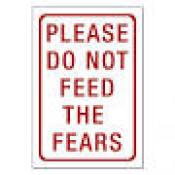To Fear or Not to Fear. . . That is the Question
![]()

Something caused Miss Nancy to look up from our supper preparations.
“That’s a bear,” she said. A moment passed for her to focus on the beast with the shoulder hump before she followed up with more vigor, “That’s a fucking bear!”
All eyes followed her gaze to the silver-backed grizzly that was ambling towards our camp.
Our party of six canoeists was descending the remote Wind River in Canada’s Yukon Territory. We had made camp at the base of a long steep ridge that ran parallel to the river.
The moment we saw the bear, our fight-or-flight response kicked in. The amygdala, that almond-sized feature deep in the center of our brain, signaled the threat. This ancient part of our brain creates instant responses — sometimes good, sometimes bad.
In this case our prefrontal cortex vetoed the amygdala’s first response: to flee. The prefrontal cortex is located directly behind our forehead. It is the planning center where decision-making and mental processes take place. Unlike the primitive character of the amygdala, this forefront of the brain is a relatively late feature in the evolution of humans. These two brain loci often wrestle with each other, sometimes causing delays or a poor decision. Ill decisions can result in serious injuries or death.
We knew that you never run from a grizzly bear. Our flight might trigger an attack. Knowing that, all of us merged together resembling a twelve-legged oddity.We picked up a nearby bear spray and realized that the other two cans were in the tents, some fifty yards away. So like a moving football huddle we slowly shuffled towards the tents and recovered the other two cans of high-octane pepper spray.
By this time, the bear was thirty yards from us. Nothing about the bear’s body language appeared threatening. . .yet.
Luckily for us and perhaps for the bear, a gust of wind caught a loosened corner of our tarp lean-to. It cracked loudly, like someone snapping a towel at the bear’s derrière. The sound sent the bear running.
For hours afterwards, we all experienced a welcome blend of feelings. There was a rush of pleasure tempered with a splash of nervous giddiness and sweet horror.
As I worked on writing the four regional editions of Things that Bite: A Realistic Look at Critters that Scare People, it became clear to me that we humans often wallow in unfounded fears.
While bear attacks on humans make the front page of newspapers across the continent, bees and wasps are responsible for far more deaths per year than bears. Their stings can trigger anaphylactic shock and potential death in approximately 2% of our population. Yet have you ever seen a front page story about a bee attack?
And now, as if bees and bears aren’t enough, we are fed daily doses of fear from the media. We are supposed to think that disease carrying mosquitoes and shadowy terrorists are lurking right outside our door. As a result we become paralyzed instead of exercising critical thinking skills in our brain’s prefrontal cortex.
I recently saw a clever photo of a sign that was altered by changing one letter. It said, “Please Don’t Feed the Fears.” I wish all media outlets would post that sign in every journalist’s cubicle.

The reality is that while you are enjoying a summer parade you are statistically more likely to be killed by a lightning strike than by a terrorist, bee sting or a bear attack.
So get outside, take a deep breath, embrace your lightning quick amygdala and exercise your prefrontal cortex.


